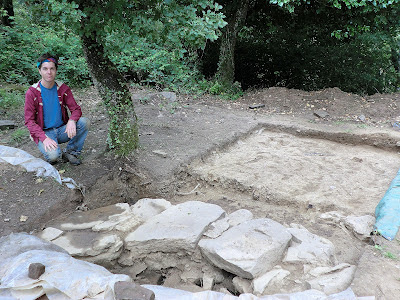The allure of Italy is well-known. Every year droves of
tourists flock to her major cities – Rome, Florence, Venice – seeking to
experience for themselves the country’s fabulous art, food, and fashion, to
savor a few days of la dolce vita
before moving on to their next destination. People travel to Italy to relax and
enjoy themselves. They go for pleasure and are always surprised to hear my
reason for going each summer: to perform strenuous manual labor under the
Tuscan sun (don’t be misled by the book) and not get paid for doing any of it.
Folks who don’t understand my motives sometimes think I’m crazy, but I go for
the experience – the opportunity to dig in Italy. As a student of classical
archaeology, what I’ve gained from excavating at FSU’s field school at Cetamura
del Chianti has far exceeded any minor discomforts felt along the way. My time
at Cetamura has been extremely rewarding, offering me a foundation in my field and
opportunities to pursue my own research queries.
After I tell someone that I dig in Italy and the person asks
me if I do the same sort of thing as Indiana Jones (answer: not at all!), the
next question is always, “Have you found anything interesting?” My first summer
I found very little by way of artifacts aside from a pair of ca. 1980
sunglasses dropped by a lost German hiker. We did, however, observe a peculiar change
in soil composition within my trench that year. Along one side of the unit, a
curved cut had been made in the surrounding bedrock and filled in with a dense
clay pack in antiquity. Given the semi-circular nature of the cut and the
presence of the water-retaining clay, we hypothesized that a water containment
structure might lie in the adjacent unit. I returned the following summer to
investigate the neighboring area. What we found was a large, roughly circular
stone-lined cistern or well! The cavity at the center of the structure had
evidently been filled in with stones and discarded roof tile at some point
(likely when it failed to adequately collect and/or store water), and this is
where we focused our attentions that second summer. In order to get to the
bottom of some of our most pressing questions – what was its precise function,
when was it in use, who had access to its contents, etc. – we had to get to the
bottom of the cavity!
 |
| The hypothesized cistern under excavation in 2011 |
 |
| The western portion of the structure, revealed in 2012 |
While we didn’t reach the bottom of the structure in 2011,
we did learn a great deal about its form and method of construction. In the
process of doing so, we also succeeded in expanding the map of Cetamura. Yet
there were still so many unanswered questions. I had to return in 2012. My
third summer I set to work uncovering an unexcavated corner of the structure.
My goals were to complete a detailed map of the structure (that took into
account the unexcavated portion), determine the extent of the clay pack
observed in 2010, and see if we couldn’t come up with a better interpretation
for its use at the site. In general we met these objectives. We completed the
map of the structure and proved that the clay pack continued around all sides
of the structure. There is now little doubt that the structure was designed for
the provisioning of water. To clarify its relationship to the nearby sanctuary
and site as a whole, more work will have to be done around and, especially, within
the structure. For the time being, questions of access and usage will
have to remain unclear. We also remain uncertain about the date of construction
and time of infilling. The cavity at the center of the structure is likely to contain our
best evidence for how it was used and when it was in operation. The work
of future seasons will concentrate on the center of the structure.





